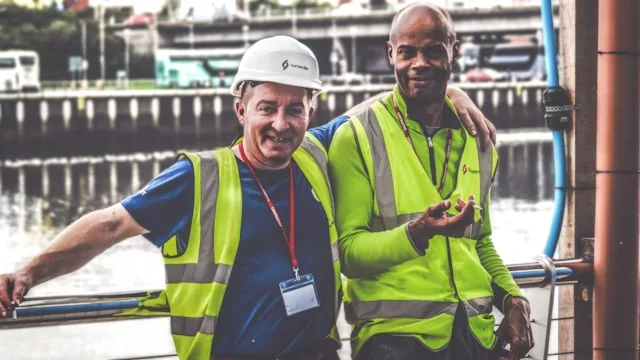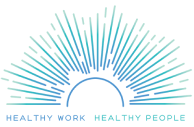Healthy Work Tools
For Individuals
What can I do now?
If you took the Healthy Work Survey to find out if you have (un)healthy work, please check out these additional recommendations, tools and resources from experts in the field of work stress to help you take action to address the work stressors (sources of stress at work) that could make you ill.
You have found out that you are experiencing particular forms of work stress.
Remember, these resources are meant to complement your own personal resources, which may include:
➔ Trying your best to get enough sleep, eat healthy foods, and be physically active.
➔ Taking care of your health conditions.
➔ Learning strategies to manage symptoms of stress.
➔ Sharing your work experiences with co-workers and learning how they may be having similar experiences.
➔ Getting support from coworkers, family, friends, or professionals.
Not one set of recommendations fits all. Remember to think carefully about your own work situation before deciding on the best course of action for you. Acting together with others (collective action) is almost always more effective than standing alone.
RESOURCES TO HELP YOU PERSONALLY COPE WITH WORK STRESS
First – take care of yourself as suggested above, particularly if you are experiencing any symptoms of stress. Even if you have found out that you have work stress but you feel well, you can still take action to prevent stress from getting worse and taking a toll on your health and well-being in the future.
Second – you are probably not alone in how you are feeling. Many others in your workplace or in similar occupations/organizations may be experiencing the same thing. Talk to your co-workers and find out if the work stressors you are experiencing are shared by others at your workplace.
Third – talk to your supervisor if you believe they will be supportive and open to the ideas you offer. You could also share the Healthy Work Agenda with them or the Business Costs of Unhealthy Work.
The resources below complement the information provided on our website and will help you further understand what work stress is, how it affects your body, and offer guidance from respected organizations on how to cope with work stress as an individual:
- American Psychological Association (APA) – Coping with Work Stress
- NIOSH Stress at Work guide
- HelpGuide.org Stress in the Workplace: Managing Job and Work Stress
- Substance Abuse and Mental Health Services Administration – Tips for Health Professionals Coping with Stress and Compassion Fatigue
RESOURCES FOR COLLECTIVE ACTION AND WORKER ORGANIZING
As individuals, we are often told to work hard and not complain. We are grateful to have work and many of us may believe in the idea “just be glad you have a job.” What other choice do we have? But we also have a right to a safe and healthy workplace. This was not always the case (and is even now not adequately enforced).
It wasn’t until workers stood together collectively through strikes, protests or demonstrations, and by joining unions, that working conditions started to improve. Along with public health advocates and others, workers and their unions demanded safety standards and regulations that protected them from unhealthy toxins at work (e.g. coal dust or asbestos) and unsafe facilities and equipment, which led to the U.S. Occupational Health and Safety Act (OSHA) in 1970. While safety issues have declined thanks to collective actions, the dangers of work stressors have been on the increase.
Collectively we often have more power than we do as individuals.
Taking action on your own is difficult, especially about invisible hazards like work stressors. It’s easier to do these things with others; so team up and don’t try to go it alone. Look for support/help from coworkers, family, friends, and community/worker organizations. (See the organizations and resources below.) And check out our HWC Resources for Workers & Unions to Document & Reduce Job Stress sheet to take it a step further. US federal law (National Labor Relations Act) protects you when you and others take “concerted action” (action together) about these kinds of health and safety issues.
FIRST - Learn about strategies that address work stressors.
Strategies that unions, other worker advocates, or researchers have used to address or reduce specific “psychosocial work stressors.”
Address demands, control and support.
Safe nurse-patient staffing ratios: A coalition of nurses unions (National Nurses United) have been standing together to pass Federal legislation based on the California safe-staffing ratios law passed after a 13 year struggle in 2004. Studies show that higher staffing ratios save lives; yet understaffing is a major issue RNs struggle with every day. Understaffing impacts their “workload/demands” and can lead to burnout and high turnover. Whether or not you’re a nurse, join efforts to support this legislation that protects us all, as well as promotes healthy work for nurses.
A labor management study to reduce workplace stressors and burnout: This was a study by researchers with healthcare staff and unions in a hospital in Quebec, Canada beginning in 2001. It is one of several studies that have involved a team of workers (in this case, healthcare professionals and other stakeholders in the hospital). They met regularly to come up with specific ways to improve the health of all care staff at the hospital by reducing work stressors including: improving teamwork (support), staffing (demands), work organization (hours, schedules), training (skill discretion, job control), communication (support) and ergonomic design. It was highly successful after three years, stressors and worker burnout were significantly reduced. Taking part in a study is not always possible, but you can set up and/or join a workplace committee or team at your workplace that is interested in assessing healthy work and coming up with innovative ways to reduce or prevent stressors. Find examples in other studies for more ideas about how you can work with others to improve your work.
Housekeeper Study and Workload Reductions: Hotel housekeepers face a higher risk of injury than other hotel workers, in part due to high workload and pressure to clean hotel rooms quickly. In 1999, the hotel workers union in San Francisco, after documenting hazards faced by the housekeepers, was able to bargain a contract, reducing the hours quota that each worker was required to clean in a day from 15 to 14. Since then, hotel workers and their union (UNITE-HERE) have bargained contracts on workload, conducted research, educated workers and the public, helped pass a California regulation on preventing hotel housekeeper musculoskeletal injuries, and also campaigned against sexual harassment of hotel housekeepers. Find out more and how you can help.
The Healthy Workplace Participatory Program at the Center for the Promotion of Health in New England (CPH NEW), a NIOSH Total Worker Health® Center of Excellence, provides a scientifically-developed toolkit that engages employees in addressing a wide range of work environment, work organization, safety, and employee health issues. It works for starting new programs or enhancing existing programs and includes tools to check whether your organization is “ready” and information to help convince management of the necessity for this kind of program. You can pair these tools with the Healthy Work Survey, conduct focus groups with employees/coworkers, learn how to create teams to design “interventions” (programs that can address work stressors like demands, support, work-family conflict, etc.) and find ways to implement and evaluate those programs.
Address shift work, long work hours, and inadequate/irregular work hours.
US Department of Labor – Laws governing work hours: The Fair Labor Standards Act (FLSA) does not limit the number of hours an employee can be required to work. For non-exempt employees (usually wage earners), the FLSA requires workers to be paid at time-and-a-half after working 40 hours in a work week. The FLSA also has no provisions regarding employee scheduling, so an employer can change an employees hours and schedule without notice or without obtaining employee consent, unless there is a prior agreement between an employer or employee/employee representative (e.g. collective bargaining contract).
Changing “on-call scheduling” and irregular schedules: Food service workers, retail workers, cleaners and many other occupations have irregular or “on-call” schedules which play havoc with people’s lives, like scheduling child care at a moment’s notice, finishing college courses, etc. Some success stories addressing these issues include: 1) San Francisco, which was the first city in the U.S. to pass a Retail Worker Bill of Rights (in 2014), and 2) retail workers and others who came together in New York City and successfully passed a law in 2017 that ends “on-call” scheduling in the City. Support the Schedules That Work Act, a bill in Congress that seeks to remedy this problem nationally.
NIOSH resources on sleep, fatigue, shift-work and long hours: A significant number of U.S. workers are exposed to health and safety risks associated with shift work, long work hours, and related workplace sleep and fatigue issues. If you are working in the aviation, transportation, and healthcare industries, are an emergency responder, or otherwise find yourself working long hours and night shifts, this can be particularly dangerous to your health and well-being. NIOSH has made available a webinar series and other resources about how shift work and long hours affect fatigue and sleep, as well as trainings and resources for coping.
Reduce work-life conflict and improve flexibility and control over schedule.
A Better Balance is an organization that “seeks to reduce the stress of conflicting work-family demands and responsibilities, as well as end discrimination against workers (most of whom are women) who care for their children or other family members.” They pursue campaigns to strengthen legal protections and to advance policies that provide paid leave, paid sick time, fair and flexible work, workplace equality (including gender equity), pregnant worker fairness and breastfeeding support at work. They offer you resources and information on these issues and your rights at work.
The Pregnant Workers Fairness Act – The PWFA is a new law that requires covered employers to provide “reasonable accommodations” to a worker’s known limitations related to pregnancy, childbirth, or related medical conditions, unless the accommodation will cause the employer an “undue hardship.” Some state laws extend these rights to smaller employers too. (For example in California, where you have to work for an employer with 5 or more employees). National COSH recently released a new fact sheet in English and Spanish.
The Work Family Health Network is an interdisciplinary team of researchers who have conducted research on workplace psychosocial interventions to improve the health and well-being of working people and benefit employers. These researchers found that workers supervised by family-supportive managers were significantly more likely to experience lower levels of work-family conflict, higher job satisfaction, lower intention to change jobs, and higher reports of physical and mental health. If you are experiencing work-life balance issues, check out these important toolkits. These tools can be used in your workplace to help teams find ways to reduce work-family conflict and increase productivity, by decreasing unnecessary work, increasing everyone’s control over their time and providing flexible work schedules.
The Better-Work Toolkit introduces ways in which “knowledge workers” have improved their flexibility, collaboration, and autonomy to enhance their work-life balance.
Prevent workplace bullying, sexual harassment, and discrimination.
Workplace Bullying Institute (WBI) is an organization in the U.S. that has been offering comprehensive resources about workplace bullying—for individuals who have been bullied and to organizations that want to address bullying in the workplace. WBI includes self-help advice for individuals, personal coaching, research, books, public education, union assistance, training for professionals, employer consulting, and legislative advocacy. In 2001, WBI launched the Healthy Workplace Bill, which has now been introduced in 31 states/territories. If you feel you want to get involved in supporting this bill in your state, see how you can help.
U.S. Equal Employment Opportunity Commission (EEOC) is responsible for enforcing federal laws that make it illegal to discriminate against a job applicant or an employee because of the person’s race, color, religion, sex (including pregnancy, gender identity, and sexual orientation), national origin, age (40 or older), disability or genetic information. It is also illegal to discriminate against a person because the person complained about discrimination, filed a charge of discrimination, or participated in an employment discrimination investigation or lawsuit. If you have experienced workplace sexual harassment or discrimination, you can find out more information or file a complaint with the EEOC:
Laws & guidance on protection of pregnant workers
Laws & guidance on workplace sexual harassment
Laws & guidance on filing an employment discrimination charge with EEOC
Coalition for Restaurant Safety and Health (CRSH) is a Philadelphia-based coalition that helps restaurant workers and owners identify and prevent sexual harassment. Although sexual harassment pervades the restaurant industry, restaurant workers often do not report it. They may think that their treatment comes with the job. They may fear retaliation for reporting, or they may believe that their employer won’t do anything to address it. CRSH offers free trainings to restaurants to prevent sexual harassment and to promote respectful and safe workplaces in the restaurant industry.
Helping Survivors was founded in 2022 with the mission to heal, educate, and empower survivors of sexual abuse, sexual violence, and domestic violence. Helping Survivors has created multiple work-related resource pages including Sexual Assault and Harassment in the Workplace and many resources to guide individuals through reporting sexual harassment. If you receive no support from your company or are subjected to retaliation, contact a lawyer immediately. You can also call the National Sexual Assault Online Hotline to chat with a trained staff member who can provide you with crisis support while maintaining your confidentiality.
The Minnesota Association of Public Employees (MAPE) created an anti-bullying toolkit for their union members to use. This union has led the charge in understanding and combating this serious problem and offers tools to guide workers in navigating a bullying work environment and helping those who may be victims of bullying. MAPE is working together with members to ensure a “happy, healthy and safe work environment for all.”
WorkplaceFairness.org is a non-profit organization that believes that the fair treatment of workers is sound public policy and good business practice, and that free access to comprehensive, unbiased information about workers’ rights – without legal jargon – is an essential ingredient in any fair workplace. They offer tools and networks of legal professionals who can help you understand your rights and to build a legal case when necessary. They have information on hiring and classification, harassment and discrimination, wages and hour problems, benefits, workplace surveillance, whistleblowing and retaliation, as well as health and safety.
Improve working conditions/rights and benefits for 'gig workers' or 'independent/precarious workers'.
The Portable Benefits for Independent Workers Pilot Program Act would allow the U.S. Department of Labor to authorize grants to states, local governments, and nonprofits to design new models to provide and implement “portable benefits” (retirement savings, workers compensation, life or disability insurance, sick leave, training or educational benefits, healthcare and more) for independent workers such as contractors, temporary workers and self-employed workers, and would especially benefit low-wage precarious workers. This bill could help to alleviate some of the stressors related to being a precarious/gig worker.
The National Domestic Workers Alliance: Domestic workers are housekeepers, nannies, and elder care providers. The work caring for our children, seniors, people with disabilities and other home care work that makes all other work possible, is often invisible and can be physically and emotionally demanding. However, domestic workers (who are mostly women) are “gig/temp workers” or “independent contractors” excluded from many of the basic protections guaranteed by the Fair Labor Standards Act—things like minimum wage, overtime, sick and vacation pay or health insurance. The NDWA, formed in 2007, passed the “Domestic Worker Bill of Rights” and continues to advocate for improved working conditions, leadership and skill-building. If you are a domestic worker in the U.S., you can now become a member with access to resources, benefits, leadership training, and community.
Join the Freelancers Union. (It’s free!) The Freelancers Union promotes the interests of independent workers through advocacy, education, and services. The Freelancers Union was established in 1995 and seeks to represent the 57 million “independent workers” in the U.S. They provide access to benefits such as health, dental, term life, disability, and liability insurance. They also have tools available to start or join local communities of freelancers in 25 major cities (such as SPARK) and other resources including a blog for freelancers. They also advocate for policy change including conducting the annual Freelancing in America survey and the Freelance Isn’t Free campaign.
Provide fair pay/living wage and adequate benefits (e.g. health insurance, paid sick leave/family leave/vacation time).
The U.S. Department of Labor – Fair Labor Standards Act (FLSA) establishes minimum wage, overtime pay, record-keeping, and child labor standards affecting full-time and part-time workers in the private sector and in Federal, State, and local governments that are non-exempt. Certain employees are exempt from the FLSA if they earn a salary over a certain amount or earn most of their income from commissions. (Find out if you are exempt.) You can also find information regarding work hours, leave, termination, breaks and meal times.
Fight for $15 began in 2012 when 200 fast-food workers walked off the job to demand $15/hr and union rights in New York City. Today, it is a global movement in over 300 cities on six continents. It includes fast-food workers, home health aides, child care teachers, airport workers, adjunct professors, retail employees—and underpaid workers everywhere. If you are struggling with low wages and making ends meet, find information, support or join the Fight for $15 movement. Even if you are not a low-wage worker, you can still help support the struggle for fair, living wages for all workers.
Family Values @ Work is a national network of 27 state and local coalitions helping spur the growing movement for family-friendly workplace policies such as paid sick days and family leave insurance which will result in better individual and public health, and greater financial security for families, businesses and the nation. If you are willing to work towards family-friendly work policies such as paid sick days and paid leave, there are many opportunities to get involved.
Healthy Families Act: The American Public Health Association (APHA) urges support for this bill (introduced in 2017) which would allow workers to earn up to seven paid sick days a year. Creating a national paid sick leave standard would allow millions of Americans to earn the time necessary to recover from illnesses like the flu, access health care and take care of a sick family member.
Oxfam America – Best and Worst State to Work in America index ranks states according to their wage policies (changes to federal minimum wage), worker protection policies (paid sick leave, pregnancy protections and equal pay), and right-to-organize policies. They also show that there is a relationship between a state’s ranking in the Best State to Work Index and positive economic and health indicators. The higher the index, the less infant mortality and poverty rates, and the higher the life expectancy, median income, GDP per capita, and labor force participation rates in that state.
Address physical or environmental stressors at work (e.g. unsafe equipment/facilities, heat stress, noise or exposure to chemicals).
The Occupational Safety and Health Act (OSHA) of 1970 gives employees and their representatives the right to file a complaint and request an OSHA inspection of their workplace if they believe there is a serious environmental hazard or their employer is not following OSHA standards. Learn about worker rights protected under OSHA.
ChemHat, or the Chemical Hazard and Alternatives Toolkit, is an internet database that offers up easy-to-find information about chemicals in the workplace so you can protect yourself, coworkers and family. You can look up specific chemicals by name and answer such questions as “Can this chemical in my workplace affect my health?” and “Are there safer alternatives?”
Worksafe is a California-based organization (part of the National Council for Occupational Safety and Health) and is dedicated to promoting and protecting the basic right of all people to a safe and healthy workplace. You can get free worker trainings about health and safety rights, hazard awareness, immigrant rights and workers compensation. You can also get resources to find out how to file an OSH complaint, address retaliation, or protect yourself as a whistleblower.
If you are interested in learning about how some organizations are reducing COVID-19-related work stressors, visit our Healthy Work Strategies page for more info.
SECOND – Support #healthywork. Check out these resources and organizations.*
B Corps is a community and certification process for businesses who seek to redefine success in business and to build a more inclusive and sustainable economy. The B-Corp community works towards reducing inequality and poverty, building a healthier environment, stronger communities and the creation of high-quality jobs with dignity and purpose. Certified B-Corporations undergo a rigorous assessment of the company’s impact on its workers, customers, community, and environment, and are required to amend their legal governing documents to require their board of directors to balance profit and purpose. Check out the B-Corp Directory for companies that have been certified and may offer many of the elements of a healthy workplace.
Coworker.org allows you to start, run, and win campaigns to change your workplace. Maybe the StressAssess survey has given you some ideas for areas in your workplace that need improvement and how you could create healthier work? Start by creating a Coworker.org petition and talking to your coworkers about your campaign. Every day, people are launching and joining campaigns around issues large and small—from improving an office break-room to providing paid sick leave to employees. Anything is possible when coworkers join together.
Democracy at Work Institute works to expand the model of worker cooperatives in the U.S. A worker cooperative is a values-driven business that puts worker and community benefit at the core of its purpose. Workers own the business and contribute their labor to participate in its financial success. But workers in cooperatives also have representation on and vote for the board of directors. Cooperatives are democratic and are inherently likely to provide “job control”—having a say in decision-making and about work processes. To find information about a democratic workplace near you or how to start a worker cooperative, check out the U.S. Federation of Worker Cooperatives.
Interfaith Worker Justice (IWJ) is a national network that builds collective power by advancing the rights of workers by engaging diverse faith communities and allies in joint action, from grassroots organizing to shaping policy at the local, state and national levels. IWJ has issues that align with #healthywork, including fighting against wage theft and for fair pay, health and safety, and sick pay. Find a local group you can join.
Jobs with Justice is more than an organization; it is a national network made up of thousands of organizations (labor unions, faith and community organizations, and student activists) and individuals committed to transforming the lives of working people. From fighting for economic justice, to shaping the future of work and improving labor law, you can also find support for changing your workplace including organizing for #healthywork.
National Council for Occupational Safety and Health is a federation of local and statewide “COSH” groups—committees/coalitions dedicated to advancing the rights of workers related to health and safety issues, regardless of their immigration status. COSH groups are typically non-profit organizations. You can find a local COSH group near you or find information about starting one.
*These are just a few examples of organizations that can provide you resources to more effectively work with others to make changes at your workplace. There are many more such organizations.
THIRD – Join or Organize a Union.
Unions represent workers from many occupations and industries, from janitors and restaurant workers, to autoworkers and machinists, to musicians, teachers, nurses, researchers, and tech workers. Labor unions benefit working people through collective bargaining contracts and advocating for worker rights, including health and safety and other social and economic justice issues affecting members. Unionized workers (including non-members) have higher wages, better healthcare and retirement benefits. Unions reduce inequality and fight for better working conditions which ultimately lead to healthier work.
While not all unions directly consider issues of “work stress” and “healthy work,” they are dedicated to demanding manageable workloads (job demands), giving workers a voice (job control), fighting for paid overtime or limits to work hours (long work hours), work-life balance (e.g. family/sick leave provisions and vacation time), grievance procedures and seniority/promotions (organizational justice), anti-bullying, discrimination and sexual harassment contract clauses, and occupational health and safety.
No organizations are perfect. And despite the labor movements’ fundamental democratic values, there have been cases of failed leadership. That being said, the sharp decline in union membership (34% to 8% within the private sector in the U.S. between 1973-2011) has been largely the result of globalization from outsourcing of jobs, but also because of a systematic attack on unions and worker-organizing by neo-liberal politicians, business leaders and “Right to Work” advocates. But even still, thousands of workers organize unions every year, which gives them more rights and power to have a say over pay, benefits and working conditions.
Get informed about your rights and what unions actually do for working people.
Interested in forming a union? Here’s how.
Need more information on how unions benefit workers, wages and benefits and help to reduce inequality? Check out the Economic Policy Institute and their First Day Fairness campaign that aims to increase worker power and ensure job quality.






